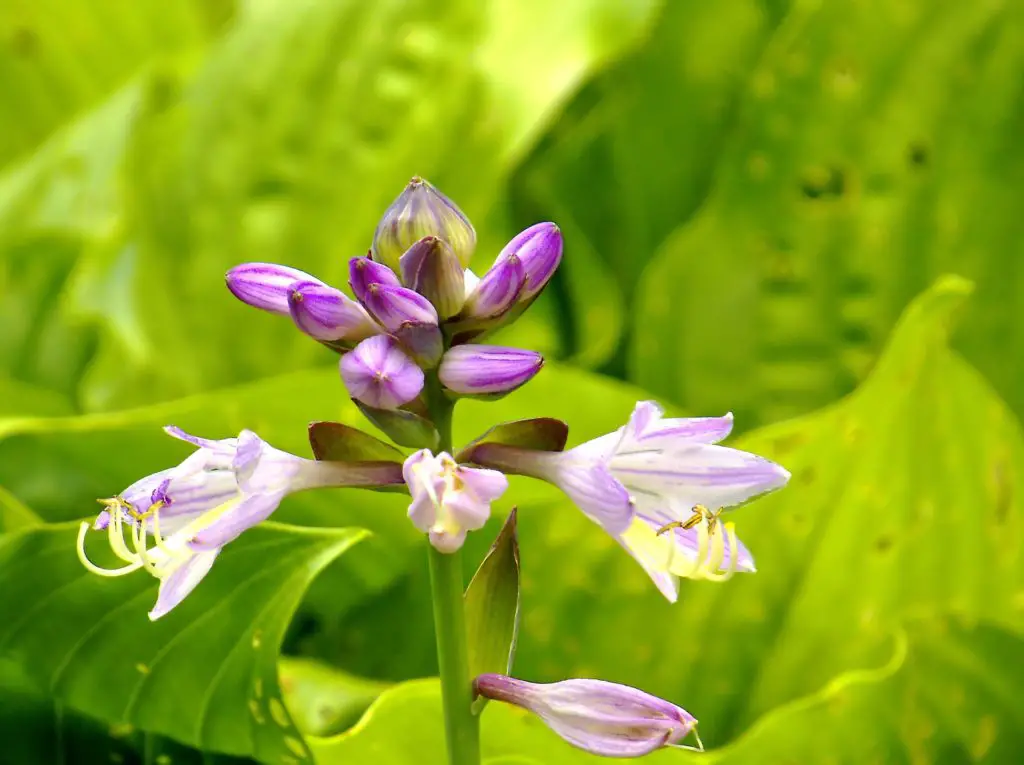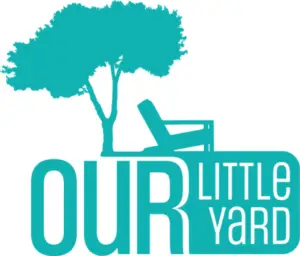Hostas are a favorite landscaping plant for many people because they are almost effortless to grow and they provide beautiful greenery to a flowerbed for most of the Spring and Summer months. They love the shade and produce large green leaves of various patterns that fill out landscaping beautifully. Hostas spread quickly and you can easily split them up and plant in other areas of your landscaping without having to buy new plants. Whether you are new to gardening or a self proclaimed expert, hostas are a great addition to any garden that will provide them with enough shade to thrive.
Hostas bloom in the Summer from May to September for about 3 to 5 weeks depending on the variety. You will begin to see large stalks shoot up from the middle of the hosta and the blooms will appear on the ends. Hosta blooms can range in color from purple to pink to white or even a mixture or striations of those colors. This floral display is an added bonus to the already cheery green of the hostas leaves.

Should I let my hostas bloom?
While hostas do provide beautiful blooms, some people may choose to cut the bloom stems before they actually flower. Allowing the plant to flower or not flower does not harm the plant, but is just a matter of personal taste. If you do allow your hostas to bloom, it is best to cut the stalk after the flower has dropped to encourage new growth. Many people prefer to cut them back as soon as they become brown and unsightly when the bloom wilts and falls off.
While hostas are already a favorite of deer, the fragrant flowers may make them even more vulnerable. This may be another reason that some people choose to cut the flower stems back, but this is definitely not a sure way to deter the deer. They also love those big, green luscious leaves and can wreak havoc in just a single night.

How to trim hosta flower stalks
Whether you trim the flower stalks before or after they bloom, there is a proper time and way to cut them down.
- Removing hosta flowers stalks before they bloom
If you choose to remove the flower before they bloom, then you should do so as soon as the stalks begin to form but before the flower buds open. This will happen in late spring or early summer. To properly trim the flower stems from the plant you should remove them completely by cutting them at the base. - Removing hosta flower stalks after they bloom
If you prefer to enjoy the blooms, then you can trim the stalks when the last blooms begin to wilt and fall off. Again, be sure to trim the flower stalks at the base to remove them completely.
How do you keep hostas blooming?
Hostas are not heavy feeders, but you can add a slow release fertilizer in the early Spring that will promote early healthy growth and strong blooms. Be sure to plant your hostas in a location where they will have shade, rich soil, and water them consistently. If the soil is not great quality where you want to plant your hostas, simply work some fertilizer or compost into the soil when you plant them and add more nutrients each spring.
Do all hostas flower?
The majority of hostas are the flowering type and produce blooms in the summer, but some do not. If you are someone who likes to trim hostas before they bloom or prefers that they don’t bloom at all, you may want to consider the following types of hostas for your landscaping.
Hosta clausa var. Stolonifera is a non-flowering type with medium to dark green leaves. This hosta can, however, produce purple buds that never open and eventually just fall off of the plant. It is still a good idea to trim the stalks that the buds have grown on if they do appear. This type of hosta is hard to contain and you may see it pop up all over your garden or landscaping.
Why are my hostas not blooming?
Growing and caring for hostas is very easy and there is very little maintenance required and perhaps none at all if you are in an area that gets sufficient rain. There are, however, some conditions that can lead to your hostas not flowering. While hostas do love the shade, they do still require sun and if your yard is too shaded with very little sunlight, this can cause your hostas to not flower.
If you have a hosta that has always flowered in the past and suddenly one year it fails to bloom, you may have to carefully inspect the leaves for pests. Hostas are very popular with slugs and snails. If you find a slimy trail or large holes in your leaves, then these pests might be the culprit.
Hostas tend to grow and spread fairly quickly under the right conditions and therefore, many people like to divide them and plant in other areas of the garden. If you have recently divided your hostas, this could prevent your hostas from flowering, but they should recover by the next season and begin flowering again. The real showpiece of hostas is the lush green leaves, so when you have hostas that do not flower, there is still plenty of beautiful foliage to enjoy.
Are hostas good for pollinators?
The hosta blooms, while some may not be particularly fond of them, do serve a purpose. The small blooms of a hosta are attractive to pollinators like bees and this may be an important consideration before deadheading the blooms. Due to the small tubular shaped flower, the main pollinators attracted to hostas are bees and hummingbirds with their long slender beaks.
Hostas are a great addition to landscaping where lush green foliage is desired. They are very shade tolerant and can grow large fairly quickly in the right conditions. Hostas are a very popular choice for flower beds because of their large green leaves and the way they spread and fill out the garden. The blooms are often an attractive and fragrant bonus to the prized green leaves which make their appearance in late Spring or Summer. Planting different varieties of hostas provides a beautiful showing of different leaf patterns and various colors of blooms to enjoy throughout your landscaping.
